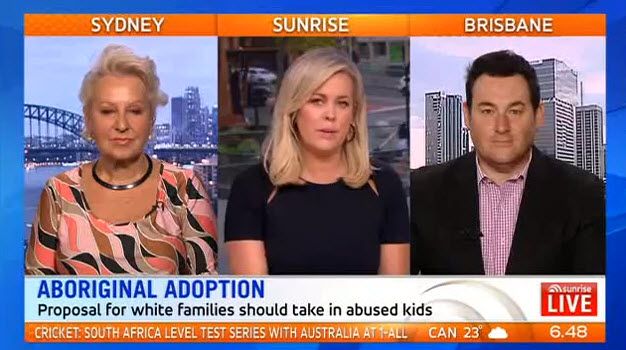
It’s perhaps no surprise that among the many, well-documented issues with Sunrise‘s disastrous panel on Tuesday dealing with whether Indigenous children should be adopted by “white” families, their lazy journalism extending to misusing file footage they had no permission to use.
What appeared to be blurred file footage of Indigenous people played while commentator Prue MacSween said that some of the Stolen Generation children were removed for their own good, and broadcaster Ben Davis agreed with her.
The filmmaker who took the footage, David Smith said he shot it for a non-profit organisation about three years ago who only provided it to Seven to promote a fundraiser, and explicitly saying it was only to be used for that purpose.
Smith told Crikey that while the footage had been breached (which Seven says is the reason it has removed clips of the segment from its social media profiles), he was more concerned about the fact that the footage had been used as stock footage for the opposite purpose of what it was intended — promoting a community-led program. He said the same footage was used by Sky News for a story it ran a few weeks about about the Tennant Creek alcohol restrictions.
“It was used completely out of context to how it was created, and the fact that it was used without permission is inappropriate and annoying, but the bigger picture is that what this is doing to this narrative is damaging,” he said.
Jack Latimore is daily editor at Indigenous X — an Indigenous owned and run independent online media platform– and told Crikey that it was common for media organisations to misuse or misrepresent Indigenous communities when using file footage.
“Obviously it’s going to effect all levels of trust in Aboriginal communities,” he said. “They’re not particularly overjoyed when they see cameras around because of a long history of misrepresentation.”
He said file footage could often be used, particularly for negative stories, to perpetuate ideas and stereotypes about Indigenous people including taking photographs of children in communities without their parents’ permission.
Latimore said that while limited time and financial resources had some impact on how Indigenous people were represented in the media, another factor that added to misrepresentation was attempts by commercial media to be outrageous for the sake of generating ratings or online clicks.
“They very deliberately frame stuff with the polemic mindset and hang the consequences and the impact on a minority and being socially divisive. It’s clickbait, essentially,” he said. “It becomes like an episode of Frontline.”
Latimore said the best way to address misrepresentations was to consult with Indigenous people in the newsrooms and to have more Aboriginal and Torres Strait Islander journalists in newsrooms, or even consultants who can advise on what is or isn’t culturally appropriate or sensitive. He also suggested more regular cultural awareness training, which is irregular at best at the ABC, and almost non-existent at most of Australia’s news organisations, as well as including Aboriginal people in the conversations.
“There are still not enough Aboriginal people in newsrooms that people making decisions are receiving direction from. So when someone in the newsroom sees this footage, they say, ‘well, that will do’, without knowing the consequences,” he said.
Some of those consequences could be well-researched physical and mental effects in the misrepresented communities and long-running trauma, Latimore said. He also said misusing footage or insensitive reporting could lead to further divisions in communities, sometimes including governance, or lead to increased lateral violence.
Seven did not respond to Crikey’s questions as to why the footage was used, other than to say: “The segment was removed from online platforms at the request of the original copyright owners of the vision featured.”
Sky News did not respond to a request for comment at all.








Cant wait till the sun sets on Sunrise!
Cultural awareness courses and sensitivity training?
F**k that, drag these pr*cks in front of a judge.